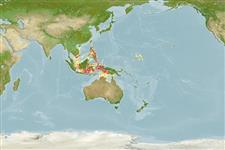Patiriella pseudoexigua Dartnall, 1971
| Native range | All suitable habitat | Point map | Year 2050 |

|
| This map was computer-generated and has not yet been reviewed. |
| Patiriella pseudoexigua AquaMaps Data sources: GBIF OBIS |
Upload your photos
Google image |
No photo available for this species.No drawings available for Asterinidae.
Google image |
No photo available for this species.
Classification / Names Common names | Synonyms | CoL | ITIS | WoRMS
Asteroidea | Valvatida | Asterinidae
Environment: milieu / climate zone / depth range / distribution range Οικολογία
; εύρος βάθους 0 - 45 m (Ref. 81020). Tropical
Κατανομή Χώρες | Περιοχές FAO | Οικοσυστήματα | Παρουσίες | Εισαγωγές
Western Central Pacific: South China Sea (to be completed).
Length at first maturity / Μέγεθος / Βάρος / Age
Maturity: Lm ? range ? - ? cm
Life cycle and mating behavior Γεννητική Ωρίμανση | Αναπαραγωγή | Γεννοβολία | Αβγά | Γονιμότητα | Προνύμφες
Members of the class Asteroidea exhibit both asexual (regeneration and clonal) and sexual (gonochoric) means of reproduction. Life cycle: Embryos hatch into planktonic larvae and later metamorphose into pentamorous juveniles which develop into young sea stars with stubby arms.
Main reference
Αναφορές | Συντονιστής | Συνεργάτες
Lane, D.J.W., L.M. Marsh, VandenSpiegel and F.W.E. Rowe. 2000. (Ref. 81020)
IUCN Red List Status (Ref. 130435: Version 2024-1)
CITES status (Ref. 108899)
Not Evaluated
CMS (Ref. 116361)
Not Evaluated
Threat to humans
Human uses
| FishSource |
Εργαλεία
Περισσότερες πληροφορίες
Trophic Ecology
Τροφικά αντικείμενα
Δίαιτα
Κατανάλωση τροφής
Σιτηρέσιο
Θηρευτές
Δίαιτα
Κατανάλωση τροφής
Σιτηρέσιο
Θηρευτές
Ecology
Οικολογία
Home ranges
Home ranges
Population dynamics
Αύξηση
Age/Size
Length-weight
Length-length
Length-frequencies
Mass conversion
Στρατολόγηση
Αφθονία
Age/Size
Length-weight
Length-length
Length-frequencies
Mass conversion
Στρατολόγηση
Αφθονία
Life cycle
Distribution
Human Related
Προφίλ υδατοκαλλιέργειας
Stamps, Coins Misc.
Stamps, Coins Misc.
Outreach
Taxonomy
References
Διαδικτυακές πηγές
BHL | BOLD Systems | CISTI | DiscoverLife | FAO(Publication : search) | Fishipedia | GenBank (genome, nucleotide) | GloBI | Gomexsi | Google Books | Google Scholar | Google | PubMed | Δέντρο Ζωής | Wikipedia (Go, αναζήτηση) | Zoological Record
Estimates based on models
Preferred temperature
(Ref. 115969): 24.6 - 28.9, mean 27.5 (based on 288 cells).


